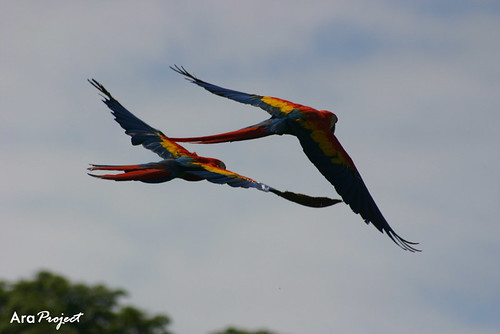 Scarlet Macaws (Ara macao)In Guatemala, the scarlet macaw, a dazzling, highly prized, and endangered parrot known as the "guacamaya," faces a double threat to survival—armed poachers and fires. But conservation efforts confront a nexus of local commercial and political pressures that only aggravate the environmental threats.
Scarlet Macaws (Ara macao)In Guatemala, the scarlet macaw, a dazzling, highly prized, and endangered parrot known as the "guacamaya," faces a double threat to survival—armed poachers and fires. But conservation efforts confront a nexus of local commercial and political pressures that only aggravate the environmental threats.
Guacamaya chicks fetch between U.S. $100 and $650 in the black market for exotic pets, which has led to a bizarre situation: Poachers, called guaceros, stalk biologists to locate macaw nests.
Guacamayas nest 60 to 90 feet (18 to 27 meters) up in trees. Once the biologists finish a survey, the guaceros—armed with guns and climbing gear—shinny up the trees and steal the fledglings.
"The guaceros are very aggressive, very well armed, and get the chicks no matter what," says Roan Balas McNab, a biologist with the New York-based Wildlife Conservation Society and the director of a 30-researcher team in the region.
The Guatemalan government assigned armed guards to protect the biologists. But in late April a guacero shot and wounded one of three guards accompanying a researcher. Just last week, another gang of guaceros ambushed researchers, who escaped. But McNab canceled one of the macaw projects.
The scarlet macaw is listed on Appendix I of the Convention on International Trade in Endangered Species of Wild Fauna and Flora (CITES). Appendix I includes those species that are most endangered.
The northern Central American subspecies of scarlet macaw, Ara macao cyanoptera, has dwindled to a population of less than 1,000.
Guatemala's three key nesting sites are in the El Burral and El Peru regions of the Laguna del Tigre National Park and in the Sierra del Lacandón National Park. All the sites are within the 2.1 million hectare (8,100-square-mile) Maya Biosphere Reserve, the largest protected area in Central America, established in 1990 by the Guatemalan Congress.
Biologists Fight Fires, Chicks Vulnerable
Together El Peru and El Burral—a new nesting site discovered by WCS biologists earlier this year—contain about 80 percent of Macaw nests in the whole country.
"These birds are perched on the edge of extinction, but we still have time to strengthen the population," says McNab. "We need to solidify our presence in the area, and gain the support of the local community—nature will replenish herself."
But deliberately set fires have sidetracked the biologists. During one of the most severe dry seasons in the reserve's history, when fires threatened nesting trees, the whole research team turned to creating fire lines.
The poachers took advantage and moved in. Of the 55 eggs hatched in El Peru and El Burral this year, only three fledglings were still in their nest as of last Friday. "About 52 were stolen or eaten by natural predators just over the last few weeks," says McNab.
This year, according to data from CEMEC (Centro de Monitoreo y Evaluación de CONAP), fires have swept through at least 400,000 hectares (1,500 square miles) of Maya Biosphere Reserve.
Land development practices not only increase the fire risk but also impinge on wildlife habitats. By law, a landless Guatemalan can clear unprotected national land, plant crops, and claim title. But the boundary between protected and unprotected lands is often a matter of dispute.
Land-Grabbing In National Parks
"Peasants set fire to the land to clear the forest for farming," says Marie Claire Paiz, a biologist for the Guatemalan environmental organization Fundación Defensores de la Naturaleza and director of the Sierra del Lacandón National Park.
Often small farmers grab land on behalf of wealthy cattle ranchers. "You know this is happening because suddenly someone will buy a series of contiguous plots and move in their animals," Paiz says.
Politics are another complicating factor.
"This is an election year, and there is a complete lack of presence in places where environmental law needs to be enforced," says Jody Stallings, team leader for FIPA, a local environmental project sponsored by the Washington, D.C.-based International Resources Group.
McNab and Paiz feel that the government is unwilling to use force against the local people—fearing retribution at the polls in November.
Paiz cites a lawless intrusion into an area in Lacandon National Park, close to macaw nests—and filled with Mayan archaeological sites.
About a hundred machete-brandishing squatters have set up there, hunting wildlife like the tapir and looting the sites. So far the police have been ineffective in clearing the area, according to Paiz.
"I have five eviction notices from the judicial system and they are just not executed," says Paiz. "If you can't get rid of invaders on private property, in a national park, then what can you do?"